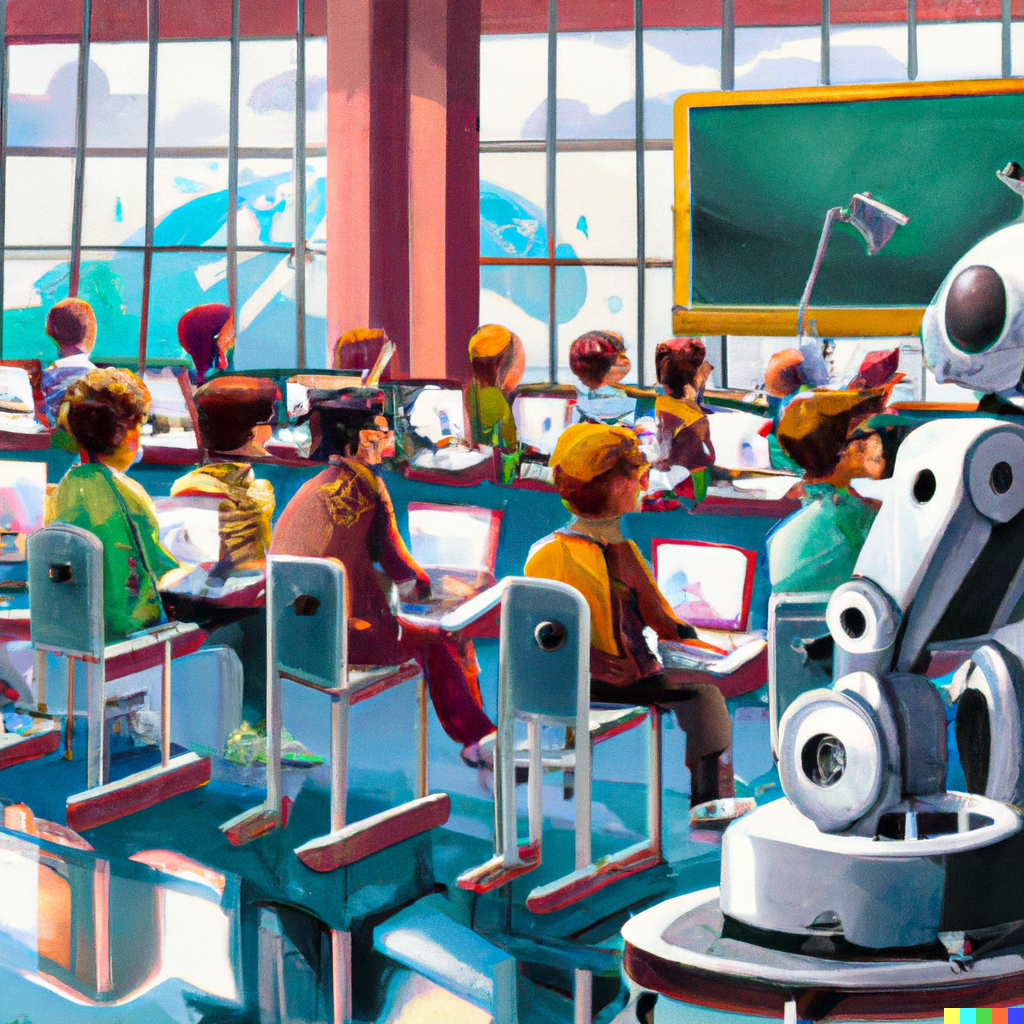
Sunday morning, I am cozied up on the couch at my parents’ house. Behind me, I hear my sister typing hastily. Frustrated, she comes to me. “I don’t want to work on this stupid report anymore! It all feels so useless.” My sister is working on yet another reflection report she has to write for her study. “Have you tried ChatGPT yet?”, I ask her calmly. “No, do you think it can write my reflection report?” “Definitely”, I say. So, I show her how to use ChatGPT. After 5 minutes she is done and joins me on the couch. My mom comes in and asks “Did you finish writing your report already?”, surprised.
This scenario might evoke various feelings. On one side, this way of working is efficient. Who wants to spend unnecessary time on a task? On the other hand, you could consider whether using ChatGPT, a natural language processing tool generating astonishingly written text, constitutes cheating or not. Do you learn from your homework, if you generate it using AI? In response to the launch of OpenAI’s ChatGPT various teachers sounded a warning. Reports of teachers’ concerns regarding ChatGPT regularly fill newspaper pages. They argue that students cannot write independently anymore and compare it to plagiarism. They fear that their teaching job will become extremely hard, as they are unable to distinguish between work generated by a computer and work done by a student. But in our opinion these statements are short-sighted. In this article, we argue that ChatGPT should not be feared but embraced by the educational system.

Banning: an impossible assignment
First of all, we want to address the challenges that come with banning ChatGPT in the educational system. While this may seem like the simplest solution, the opposite is actually true. It is already difficult for detector software to recognize work by ChatGPT. Despite considerable effort being invested in the development of detection tools, the same level of dedication is being applied to the advancement of tools like ChatGPT. Researchers worry that detectors will always stay behind on the latest improvements.
Another approach is to ban ChatGPT across all school devices and networks, firstly applied by schools in New York City. Though this might work at location, students can still get access to this software through other networks or devices.
Lastly, OpenAI has taken an approach to tackle this issue by developing a watermark. Every time text is generated with ChatGPT, an “unnoticeable secret signal” is used to generate a “cryptographic key” that functions as a watermark. However, this presents the challenge of determining which individuals should be granted access to these keys needed to uncover the watermark. While teachers could surely benefit from this access, freely distributing these cryptographic keys may lead to misuse such as circumventing the watermark. Furthermore, OpenAI will potentially miss the opportunity to gain profits, making it very unlikely that they will encourage open access. In recognizing that ChatGPT is already in use and detecting its use is implausible, the best option is to accept the current reality and the potential challenges that come with it, rather than restricting it.
Why we need to change
Does this mean that we lost from ChatGPT? No, we can change the tide. ChatGPT gives us yet another reminder that we need to work on our educational system and even provides a chance to do so. For decades we have seen new inventions stir up the educational system. Think of Google, which was portrayed as a threat to education because of its potential to easily disseminate inaccurate information and distract students from their studies. However, as the internet developed and online education services became more popular, Google became a form of resource for students and teachers alike. Nowadays, Google and other specific tools, such as the spelling-checking tool Grammarly, are widely used and accepted as assisting tools. Despite this acceptance, technophobia among teachers remains an issue that has persisted over the years and continues to be a prominent problem today.
Therefore, it is important to remember that it is our duty to equip students with the skills they need to navigate the current world. And the current world already makes use of many tools such as Google, Grammarly, and yes also ChatGPT. Even researchers admitted to generating parts of their published research papers with ChatGPT. So, rather than worrying about the dangers of innovation, we should focus on equipping students to succeed in the future by adding these AI tools into their toolkits provided at school.

Changing the educational system
So the next question that needs answering is: “How can the educational system evolve with this new innovation?”. First of all, we need to incorporate ChatGPT into class material. Some compare it to a calculator in mathematics, which also stirred up the educational system when first introduced. Kevin Roose, a technology columnist at the New York Times, explains: “Allowing it for some assignments, but not others, and assuming that unless students are being supervised in person with their devices stashed away, they’re probably using one.” It must be considered that this analogy is imperfect, as a calculator allows students to spend more time developing mathematical thinking, while ChatGPT partially takes away the thinking and learning that the writing process entails. Nevertheless, when a significant amount of in-class writing assignments are allocated, students will still experience this writing process to the fullest.
Bringing opportunities to the classroom
It is also important to consider the opportunities ChatGPT brings to the educational system. Not only can ChatGPT help students work more efficiently, but it provides many valuable lessons with regard to the importance of trustworthy sources, responsibility of an author, and transparency. Many critics have outlined the flaws of ChatGPT such as inaccuracy with regard to referencing and the information it provides, as well as its potential for bias. As the output of the language model solely depends on the training data it is provided, ChatGPT might ‘learn’ biased or incorrect views. Additionally, ChatGPT is only trained on data up until 2021, thus limiting the scope of its understanding and knowledge. Exactly this is what educators can use to start important discussions and come up with interesting challenges in the classroom. Think of challenging students to beat ChatGPT, let them find the flaws, and ask critical questions regarding these AI techniques along the way. Other ways to use the software in the classroom are to let it write article outlines, use it as an extra tutor, or engage with it in an AI-generated debate. Or teach students about transparency and the responsibility of being an author, an important discussion that currently even keeps well-known research papers like Nature busy. This grand variety of use cases for tools like ChatGPT shows that the possibilities are limitless, creating an intriguing and exciting future for education.
However, critics fear that the ongoing research of OpenAI will lead to AI-generated argumentation that is indistinguishable from human text. A “flawless” ChatGPT would allow for less inspiring learning experiences and challenges. But this should not be seen as an excuse to stop growing with the latest technological innovations. A “flawless” ChatGPT may still provide plenty of educational opportunities in the form of ethical dilemmas and useful applications. In turn, this will help students navigate this rapidly evolving world full of technology. And on top of this, the term “flawless” might never be applied to ChatGPT. As these language models are dependent on their training dataset, this dataset should regularly be updated and controlled. And that is assuming that there is a general answer to the question “what is a reliable and unbiased dataset?”. As OpenAI states: “During [training of the model], there’s currently no source of truth”. Therefore, the use of this software will most likely always require some kind of critical thinking.
A teacher’s best assistant
One last concern that must be addressed is that this will increase the pressure on the teaching profession even further. If teachers need to adjust their teaching strategies and put more emphasis on content and argumentation, the pressure might increase. However, this is an already existing problem, not specifically caused by ChatGPT. Hence, this problem should be addressed anyways, regardless of ChatGPT. Of course, work pressure is one of the determinants of burnout in the teaching profession, but ChatGPT might alleviate this pressure as well. From providing students with useful feedback on their essays to writing lesson plans, ChatGPT could aid teachers in cutting down on time spent on tasks surrounding their job. And in the end, attempting to work against students may require more energy, than working with them.
Embrace ChatGPT
So to prepare our students and teachers for this exciting future full of technology, we better prepare ourselves to grow. Not only is it impossible to completely ban such technology from our educational system, but we also have to realize that the challenges that come with this technology are valuable lessons for our whole society.

This image is generated with the query displayed above in DALL-E, the image generator of OpenAI.


